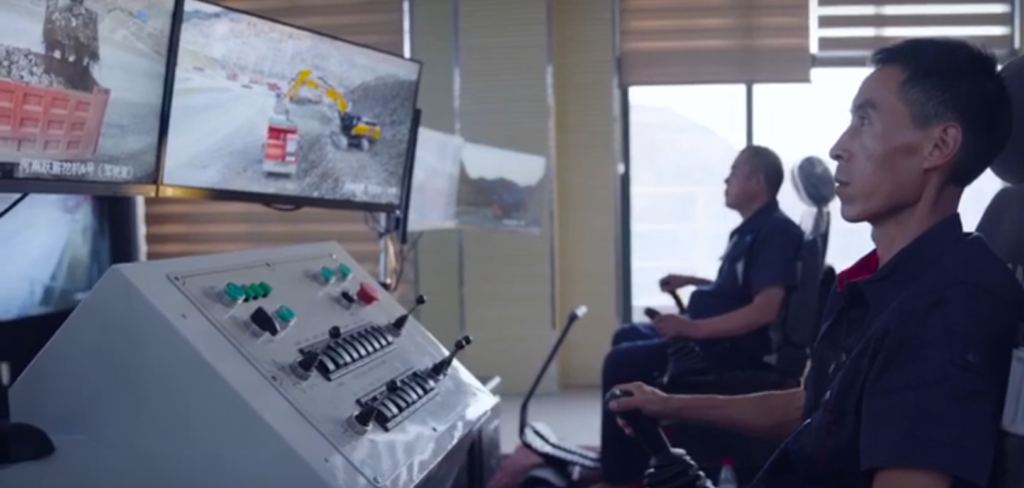Teleremote controlled mucking with underground LHDs (and then in some cases switching to autonomous tramming) from the comfort of an office on the surface has been happening in underground mining for some years now, so why not teleremote control of surface mining excavators?
A collaboration between China Mobile Henan, Huawei, Sany’s Large Excavator Research Institute, Henan Yuexin Intelligent Machinery and China Molybdenum has developed and been operating such a system for some time in a mine in Henan thanks to the application of 5G wireless network technology, taking advantage of the Ultra-Reliable Low-Latency Communication (URLLC) features of 5G networks.
Hydraulic Sany excavators in the Sandaozhuang moly mine of China Molybdenum in Luanchuan County, Henan are being remotely controlled from the main operations centre at the site, and have also been operated for demonstration purposes from other locations including from Shanghai at the 2019 MWC show, over 1,000 km away. They are loading a fleet of 30 autonomous battery electric tipper trucks whose speed has safely been more than doubled from 15 km/h to 35 km/h. Production efficiency has also been increased by 30%.
China Molybdenum’s Henan operations represent one of the first surface mining complexes worldwide to replace its 4G technologies with 5G technologies. The group has been improving unmanned mining through network development and technologies such as short-range control, long-range control, control of a single vehicle, centralised management, and smart management and control since 2015 with the 5G project realised in 2019. Nine Huawei 5G base stations have been deployed at the mining site with the wireless network now being used for the teleremote excavator loading and blasthole drill operation, as well as the autonomous operation of battery electric tipper trucks.
Chief Engineer Yang Hui from Henan Yuexin Intelligent has stated that 5G unmanned mines are able to meet multiple needs: HD image backhaul on mobile devices, intelligent scheduling systems for autonomous driving, cloud computing, and wireless transmission of massive numbers of HD images. Second, low latency is crucial to the application of autonomous driving technology for mining. According to Yang Hui, only after latency is reduced to under 30 ms will any lag be reduced and operational safety be assured. The 5G network, with its low latency, has enabled long-range remote control to become a reality at the mine. It also increased the speed limit of autonomous mining trucks from 10 km/h to 35 km/h, improving transportation efficiency. Last, 5G enables a positioning precision of less than 1 m. Replacing GPS with 5G positioning in mines reduces the cost and facilitates more-effective management of personnel and vehicles. Referring to the various costs relating to deploying 5G technology for mining, Yang Hui has said that the number of 5G-ready devices (such as 5G CPE) necessary for intelligent mining is small, so the equipment cost is not as high as it might be expected. Using the Enhanced Mobile Broadband (eMBB) feature of 5G networks, mining companies can also conduct AI-based analytics for a large number of on-site videos captured by fixed and mobile cameras to facilitate precise and efficient mining.
The machines at China Molybdenum’s operation are currently really quarry class models, but the use of larger numbers of smaller class equipment units is common in Chinese mining, and it is likely that remote control loading will be applied to larger surface excavators in China and elsewhere for loading larger class rigid AHS mining trucks. It would also seem to be the natural progression of how the mining excavator market will evolve as part of AHS projects – they will not be manned in the physical sense but will load AHS trucks via remote operator control, just as already happens underground.
Keeping the human element with LHDs and surface excavators still brings crucial human judgement to selecting the right bucket load from the blasted ore or overburden as well as being better able to react to different scenarios involving the unmanned trucks (or fleets with some manned and some unmanned machines) and make judgements on the control the machine if it is operating on uneven ground. The teleremote operator will still be able to tell the AHS truck where to spot and kick it out once loaded.











